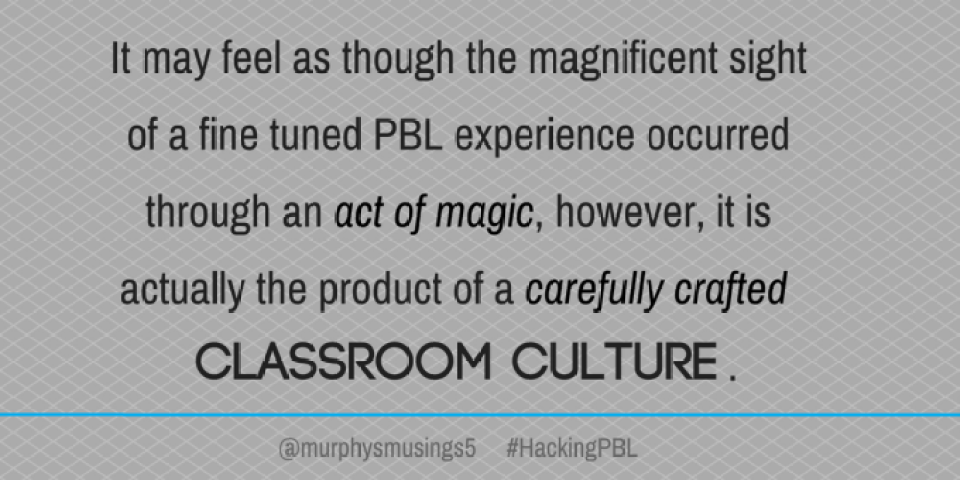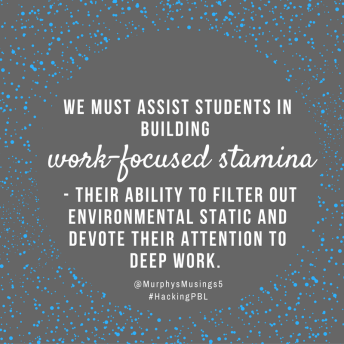Is The Classroom Culture Ready For PBL? #HackingPBL

Over the next month I will be publishing 5 posts as sneak peaks for our upcoming book, Hacking Project Based Learning, which was written with Ross Cooper (@rosscoops31) and will be released this winter.
When you observe the classroom of an accomplished project based learning (PBL) teacher, the joyful rhythm and the organized chaos can be awe-inspiring. It may feel as though the magnificent sight of a fine tuned PBL experience occurred through an act of magic, however, it is actually the product of a carefully crafted classroom culture. A really cool idea and a well planned project can fall flat, if the culture of the room is not prepared. As a classroom teacher, coach, and now an administrator, I believe an intentional focus on the inner-workings of the classroom environment make a huge impact on the success of any undertaking. So, whether you are trying PBL for the first time, looking to polish your current PBL endeavors, or assisting others in their approach to PBL, here are five critical questions to ask about a classroom culture:
Can students work independently?
If the gut answer to this question is no, then the room is probably not ready to jump into PBL. However, this is definitely NOT a reason to avoid using PBL as an instructional model. If you feel students are too “needy” to take on a project, in reality they may be the students who need it the most. Generation Z (born 1990s to early 2000s) is often pinned as having short attention spans due to the instant gratification provided by their technology driven environment. We must assist students in building their work-focused stamina – their ability to filter out environmental static and devote their attention to deep work. During a current unit or a PBL unit, provide students cognitively rigorous tasks and integrate scaffolded support as they work to meet their goals. This scaffolding may include self checklists, more frequent conferences, or a written timeline.
Who is asking the questions?
Ideally, students are asking questions which drive the learning taking place in their course. However, most classroom realities exist on a continuum approaching that goal. As the role of “questioner” begins to shift from teacher to student, teachers often express concern about students’ questions lacking focus or depth, because of this, another piece to the ideal questioning approach includes teachers implementing individualized questions. As students pose questions, the teacher may ask follow up questions to deepen the exploration, make additional connections, or fine tune the context the students are exploring. Keep in mind, these follow up questions are not meant to direct students to a teacher prescribed outcome, but instead, push student thinking and model for students how to ask deeper questions. If planning to test out PBL for the first time, it may be beneficial to build student questioning skills ahead of time. I recently visited a science classroom, where the students had just finished an investigation involving the germination of beans. While the experiment itself followed a fairly traditional model, the teacher concluded the lesson by asking students to record their follow-up questions and/or wonderings. During the next class period, students were provided time to research or perform additional experiments related to their questions. This model serves as an excellent entry point for integrating student inquiry into a lesson.
What does the space communicate about learning?
The physical arrangement of a classroom speaks volumes about the classroom culture. Rooms arranged in rows, facing the front, with the teacher desk at a prominent center are typically not places prepared to jump head first into PBL. A physical environment like this one indicates full teacher control. During a PBL, students control a lot of the decision making and project planning. A quick flip from one to the other will probably not yield a successful outcome. To shift successfully, possibly begin by arranging desks in groups or ask students to brainstorm some possible classroom arrangements. Provide students tasks or missions to complete in their groups. Model collaboration and communication skills and generate norms for working with a group. Teachers should not hesitate to model what good collaboration may look like – practice sharing, disagreeing, and compromising. Regardless of student age, children and adolescents benefit from rehearsing these scenarios.
Who owns the assessment process?
Teachers and students should share ownership over the assessment process. During a PBL unit, students are part of designing assessments and monitoring their progress toward goals. If the teacher is the master of assessment and students are strictly the recipients of grades, the grade itself feels like something happening to students. To begin shifting the ownership of assessment over to students, a clear goal should be established by teacher and students. Using a journal, blog, or video stream, students use their current work and experience to reflect on their progress toward their goal. Teachers check in with students through conferences or other forms of formative assessment, and provide students specific feedback. In addition to their self-reflection and feedback from their teacher, students should be able to give and receive feedback with their peers. The peer feedback process can also be modeled and rehearsed either during or prior to initiating PBL.
What do your families know about PBL?
It is essential to prepare your families for PBL. The implementation of PBL changes what happens in the classroom, but it also changes what happens in the home. Parents may be used to receiving a vocabulary test or some kind of graded assignment each week or nightly homework assignments practicing skills introduced during the day; those traditional activities may not occur throughout a project. This can leave parents wondering, what exactly is happening in my child’s classroom? Be proactive and prepare parents and families for the PBL by clearly stating expectations and explaining the learning process. It is also beneficial to store the project in the cloud – save directions and information online, so parents and students can access them regularly. When students keep a digital log of their project through a social media source or another online platform, it allows parents to regularly check-in and feel connected to the experience.
Making slight adjustments to current practice can go a long way in strengthening a classroom culture. Using the questions above to reflect will assist in finding success on the PBL journey.




One Comment
Pingback: